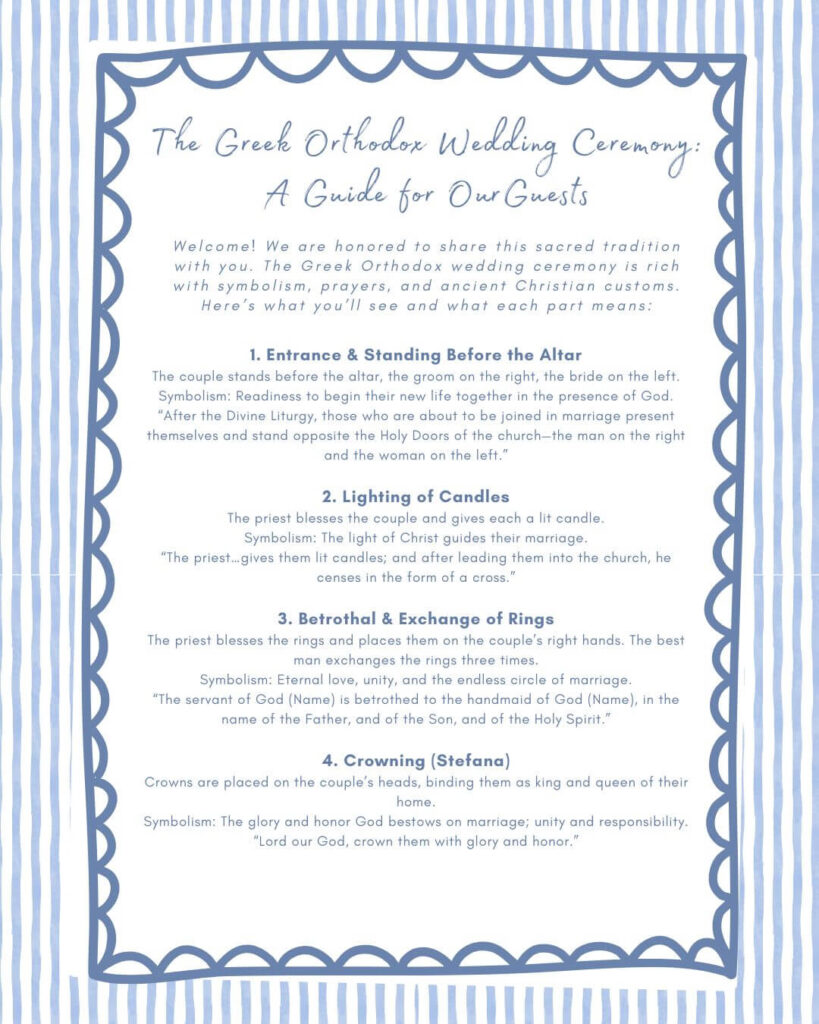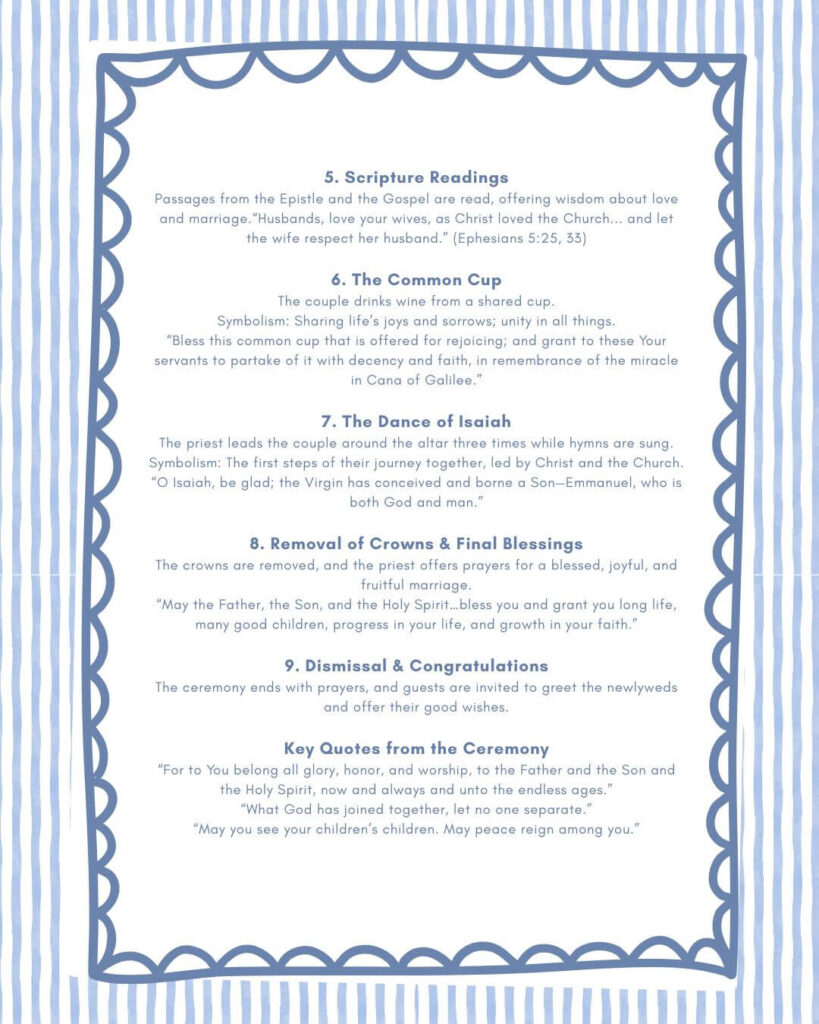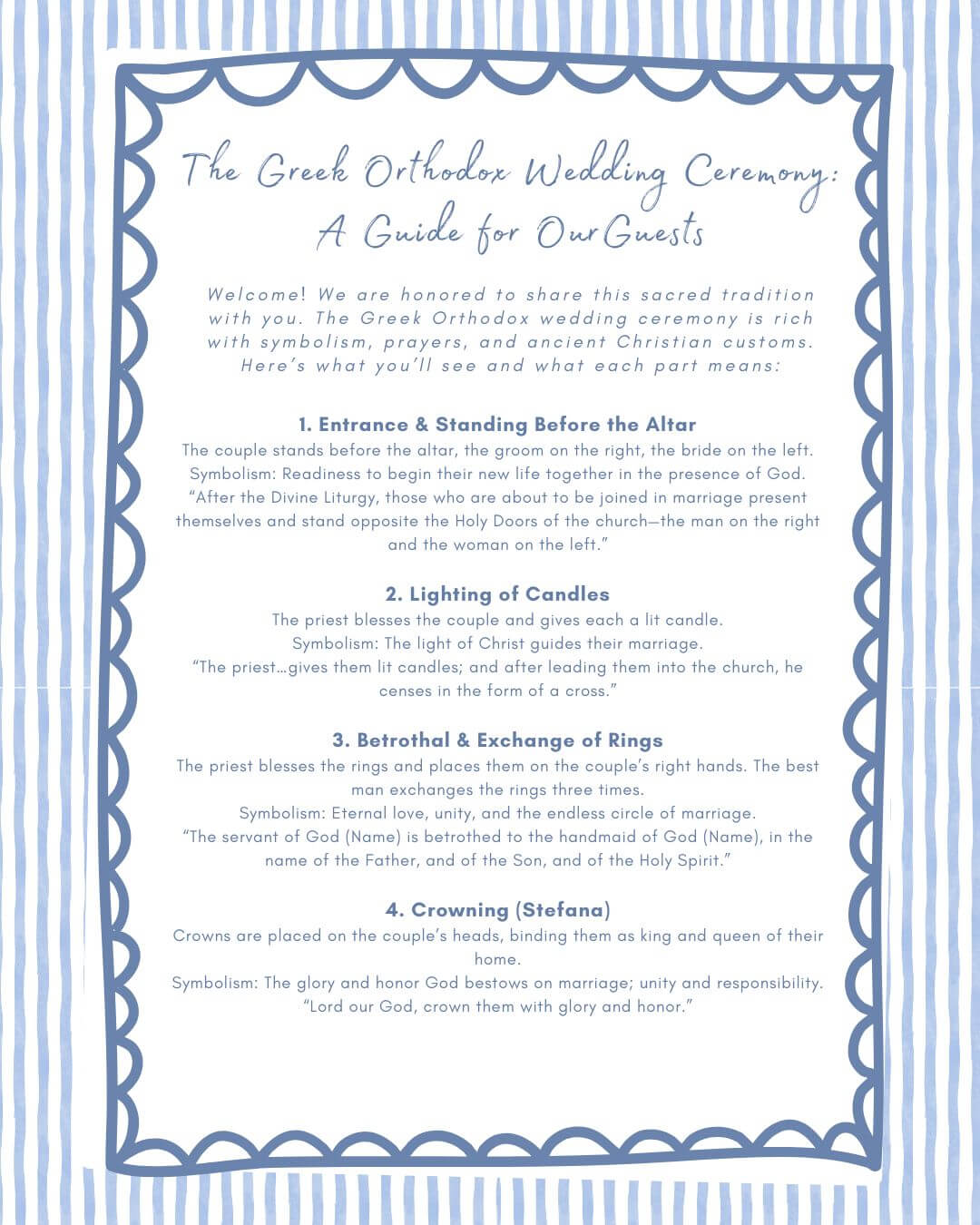Thassos has preserved rich Greek Orthodox wedding customs that blend the sacred rituals of the Church with vibrant local traditions. Like all Greek weddings, those in Thassos are community-centered celebrations filled with symbolism, music, and feasting.
What sets Thassos apart are certain regional practices that add unique color to the typical Greek Orthodox wedding framework. Below is an overview of pre-wedding customs, the structure and symbolism of the Orthodox wedding ceremony, post-wedding celebrations, and unique cultural details highlighting regional differences and communal spirit.
Pre-Wedding Rituals in Thassos
Morning-of rituals
Family and friends from the groom’s side visit the groom’s parental home (in our case, from 1 pm to 4.15 pm) to hang out together. You can come anytime you want. It’s best to arrive before 4pm so you join the carpool that the best man and groom are leading to the church. Everyone in the carpool is supposed to honk all the way until the church to announce the happy news to other people (the drive will be 15 minutes in our case).
- Shaving of the groom (to xírisma): At the groom’s house, male friends and relatives gather for “to xírisma”, the ceremonial shaving of the groom. In this custom, the koumbaros (best man) or a close friend lathers and pretends to shave the groom’s face with a razor. This is done even if the groom is clean-shaven – it serves as a symbolic gesture of trust and a final act of boyhood care before he becomes a married man.
- Dressing the bride: Friends dress the bride while singing traditional wedding songs. Historically, Thassian brides wore lavish, gold-embroidered costumes; today, most wear a white gown with heirloom accents. Once the bride is adorned, it’s time for a poignant moment with her family. Her mother leads her to a private room to give final advice and blessings for married life
- Mother’s blessing: The mother offers advice and blessings. In more traditional villages like Theologos, she may fasten a small lock at the bride’s waist and place a fine net veil for protection and to ward off the evil eye.
Bridegroom’s arrival & door ritual
The groom – accompanied by his family, friends, and often with music – comes in a joyous procession to the bride’s home.
Upon arriving, it’s not so easy for him to collect his bride; a lighthearted door ritual takes place. The bride’s friends or relatives bar the door and playfully demand that the groom “earn” his entry and the bride’s hand. According to Thassos custom, the groom must vow to do whatever is asked of him to make the bride happy, and sometimes he is challenged to sing a song or make a poetic promise on the spot.
The bride’s party teasingly finds his first vows insufficient, sparking a back-and-forth of witty remarks and serenades through the closed door. This comic negotiation continues until at last the groom is “allowed” to see his bride.
As she steps forward, the bridesmaids sing a tender local song to the groom: “O gambros, please grant us a favor – the flower we give unto you, do not let it wither”. These lyrics implore the groom to cherish the bride (the “flower”) and keep her blooming with happiness.
With that, the door is flung open, and amid clapping and ululations, the groom finally takes his radiant bride. Surrounded by cheering loved ones, the united wedding party then departs for the church – often walking through the village in procession, so that neighbors along the route can give their blessings and join the celebration.
In a traditional Thassian village wedding, this walk through the cobbled streets is filled with music, spontaneous dancing, and well-wishes, truly engaging the whole community in the upcoming sacrament.
The Greek Orthodox Wedding Ceremony (Structure & Symbolism)
Overview
Once the couple and their guests arrive at the church, the Greek Orthodox wedding ceremony begins – a solemn and beautiful rite that has remained largely unchanged for centuries.

Notably, in an Orthodox wedding the bride and groom do not speak vows to each other; their presence together in the church, willingly seeking God’s blessing, is taken as their pledge of marriage.
The ritual is actually composed of two distinct services conducted back-to-back: the Betrothal Service and the Sacrament of Crowning (Marriage). Each part contains rich symbolism and actions that signify spiritual truths about marriage.
READ ALL ABOUT THE CEREMONY IN THIS DETAILED ARTICLE WE WROTE, ALONG WITH THE ENGLISH TRANSLATION OF THE MESSAGE.
Betrothal & ring exchange
- Blessing of rings: The priest blesses the rings and places them on the couple’s right hands.
- Triple exchange: The koumbaros/koumbara interchanges the rings three times, symbolizing unity and the Holy Trinity.
Crowning service
- Lighting of candles: Each holds a white candle—the light of Christ guiding their new life.
- Joining of hands: The priest joins the couple’s right hands, signifying God’s unbreakable bond.
- Crowning (stefana): Crowns linked by a white ribbon are placed on their heads—signs of glory and honor, the couple as king and queen of their household, unity, and self-giving love.
- Scripture readings: Ephesians 5:20–33 and John 2:1–11 (Wedding at Cana) emphasize sacrificial love and Christ’s blessing on marriage.
- Common cup: The couple shares wine (often three sips each), representing shared joys and sorrows.
- Ceremonial walk (Dance of Isaiah): The priest leads them in three circles—their first steps together as husband and wife, guided by the Church.
- Removal of crowns & final blessings: The priest lifts the crowns and prays for a pure, blessed marriage, invoking biblical couples as examples.
Koufeta (Jordan almonds)
Koufeta are placed with the crowns and later given to guests in bombonières. The hard almond signifies endurance, the sugar coating sweetness, and the egg-like shape fertility. They are given in odd numbers—indivisible, like the couple.
Regional touches
- The sacred rite is consistent across Greece, but local color appears in music, songs, and small customs.
- A charming modern custom across Greece is for the bride to subtly step on the groom’s foot at the end of the service when the priest reads “And the wife shall fear (respect) her husband.” This is a wink to assert that she isn’t entering the marriage “in fear” – essentially claiming a playful equality. It’s not officially in the liturgy, but many brides do it lightly (to the amusement of guests)
- In Thassos, after the couple’s ceremonial first steps, it’s typical that there might be a joyful tune (music) as the newlyweds exit the church. The entire wedding party may even dance a bit right outside the church doors – a spontaneous expression of happiness. As we’ll see, the real festivities kick into high gear once the religious part is over.

Post-Wedding Traditions & Celebrations
Exiting the church – Rice, Petals and Cheers: When the married couple steps out of the church, they are traditionally greeted with a flurry of rice raining down on them, sometimes mixed with rose petals or confetti. Throwing rice is an ancient wedding wish for fertility and abundance; the Greek phrase “Na rizonete!” (“May you take root”) is often shouted, connecting the word rizi (rice) with the idea of a new family putting down roots. The courtyard fills with laughter as guests gleefully shower the bride and groom, covering them in symbolic grains of good fortune. (Modern weddings sometimes substitute biodegradable confetti or flower petals, but in villages like Thassos, plain rice is still common.) Along with rice, guests may also toss koufeta or flower petals, and loud cheering and ululations can be heard, underscoring the communal joy.
Congratulations Line and Bombonières: After the ceremony, it is customary for the newlyweds to stand at the church or reception entrance while all the attendees line up to congratulate them one by one. In our case, we will do that in the reception area when we come to each table to greet all of you. Each guest offers a wish or blessing – the most common is “Na zisete!” (“May you live [long]!” meaning a wish for a long, happy life together). The couple (and their families) thank each person, and in return present bomboniéra favors (which you will take at the church)– small keepsake gifts which usually contain the sugar almonds (koufeta) wrapped in tulle or lace. This exchange is a charming post-ceremony ritual throughout Greece. It allows the couple to personally greet everyone and for guests to formally bestow blessings.
The wedding feast (to glénti)
Receptions unfold in courtyards or tavernas (in a hotel in our case) and usually run late into the night (like we think it will happen in our case). Tables brim with local food, salads, appetizers, beer, local wine and different Thassian specialties. Music and dancing are central—line dances such as syrtós and kalamatianós involve everyone. Expect money dances, petal-throwing, zeibekiko solos, and plenty of toasts and laughter.
Community involvement
Weddings in villages like ous (Skala Kallirachi) are deeply communal. Families, neighbors, and even the wider village contribute food, decorations, music, and manpower. Balconies are dressed with woven rugs and embroideries, and the celebration can feel like a village-wide festival.
After the wedding day
- Church life: Couples often attend the first Sunday Liturgy together after the wedding. Historically, some communities observed a short removal-of-crowns blessing in the days following.
- “Antigamos”: A relaxed, day-after gathering with close friends and leftover food—echoing older three-day wedding feasts.
- Home blessings: Simple gestures like entering the home right foot first, sprinkling holy water, breaking a pomegranate, or lighting a candle to welcome blessing and prosperity.
Unique Cultural Details & Regional Variations
Family & roles
Greek village weddings are a family-and-community production. Elders lead matchmaking and dowry preparations; older women ensure every protocol is followed. The koumbaros/koumbara plays key ceremonial and social roles and becomes a spiritual co-parent. In Thassos’s reenactments, everyone participates—young men serve drinks, young women offer sweets, musicians play, and visitors are welcomed like locals.
Music & song
Each region has wedding songs for key moments—dressing the bride, walking to church, the first dance, teasing in-laws, and more. In Thassos, expect Macedonian-influenced island dances and lively processions. In our case, we will play a mix of traditional Greek songs, old disco songs, and English popular songs. The ratio of English to Greek music is expected to be 50-50. Modern car convoys with honking echo older, noisy village arrivals once led by musicians.
Food & symbolism
Beyond koufeta and cake, symbolic foods abound: honey and walnuts for sweetness and fertility; decorated wedding breads shared with guests to signify unity and provision; jars of local honey as favors; abundant wine and raki to toast the couple.
Dress & adornment
Historic Thassian bridal attire featured layered silk or velvet with gold embroidery and ornate headpieces; grooms wore simpler woven suits or vraka trousers with a sash. Today, Western gowns and suits prevail, often with heirloom touches—lace shawls, vintage jewelry, a sugar cube tucked in the bride’s glove for sweetness, or ivy in the bouquet for fidelity.
Superstitions & blessings
Protections against the evil eye (blue beads, incense, veils) are common. Brides may hide a blue-bead pin or sew a coin into the hem for prosperity. Single friends write their names on the sole of the bride’s shoe; the names worn off by night’s end are said to be the next to marry. Couples often receive an icon for their new home. Elders may lead a dance and bestow final blessings before the couple departs.
Conclusion
A traditional Thassos wedding, rooted in Greek Orthodox faith, is more than a single day—it’s a week-long crescendo of customs that engages every sense and every member of the community.
Pre-wedding rituals highlight family blessings and public support; the Orthodox ceremony crowns the couple with sacred symbolism; post-ceremony festivities embody philotimo and philoxenia as the community feasts, sings, dances, and gives generously.
From the mother locking the bride’s waist to village balconies draped with rugs, Thassian weddings form a vivid tapestry of culture—sending the couple into married life with joy, support, and heartfelt blessing.

